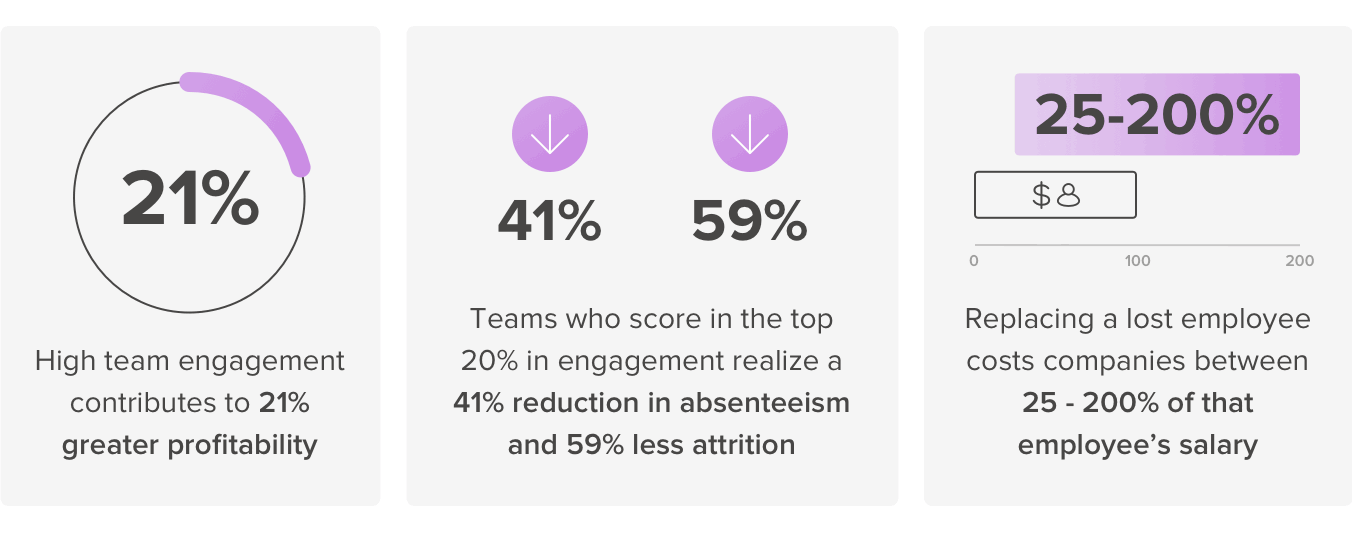In a world where a remote or hybrid work experience is the new normal, employees now have greater flexibility when choosing where they want to work and employers have added pressure to avoid turnover and improve employee retention.
The good news? Actions can be taken to help keep your talent around for longer. In fact, according to a recent Work Institute report, more than three-quarters (77%) of the reasons why employees leave are preventable. That’s why investing in employee retention strategies is time well spent.
Below, we take a closer look at what employee retention is, why it matters, and 10 strategies for boosting employee retention at your organization.
What is employee retention?
Employee retention is the ability to keep employees at your organization. There are myriad factors that influence employees’ desire to continue working for you; many are directly tied to their overall employee experience.
Some of the factors include:
- Pay and benefits
- Flexible work environment (e.g., working from home)
- Company culture
- Job satisfaction
- Feeling included and a sense of belonging at work
Measuring employee retention
Organizations calculate employee retention in order to benchmark and monitor their retention rates over time. Measuring retention will shed light on whether improvements need to be made to your employee experience management and help determine if your improvements were successful.
To measure your company’s employee retention rate (the percentage of employees who stay), you can use this simple formula:

(Number of employees at the end of a time period)/(Number of employees at the beginning of a time period) x 100 = employee retention rate
To complement this calculation, you may also want to calculate employee turnover rate (the percentage of employees who leave):

(Number of employees who left in a time period/average number of employees during the time period) x 100 = employee turnover rate
For example: If you had 10 employees at the start of a time period, and 8 employees at the end of a time period, the calculations would look like:
- Employee retention rate: (8/10) x 100 = 80%
- Employee turnover rate: (2/10) x 100 = 20%
You can also measure employee turnover by surveying your employees about their intent to stay. According to Qualtrics, intent to stay is one of the five key performance indicators (KPIs) of the employee experience. By measuring your employees’ intent to stay, you can better understand how long your employees plan to work for your organization and proactively learn why.
Why does employee retention matter?
When employees feel that their experience at work doesn’t measure up to their expectations, they’re likely to become less engaged in their work – and ultimately, will look to the job market for opportunities that better suit their work-related needs.
One or two employees leaving is natural attrition. But when many are unhappy and leave, business performance can be put at risk.
Here are a few research-backed reasons why companies should work at retaining top talent.

1. Happy employees lead to better business results
According to research conducted by the Society of Human Resource Management (SHRM), people who are engaged in their work are more likely to help the company achieve its goals. In fact, a study by Gallup showed that high team engagement contributes to 21% greater profitability.
2. Engaged employees are more present and productive at work
The same study by Gallup revealed that teams who score in the top 20% in engagement realize a 41% reduction in absenteeism and 59% less attrition.
3. Losing employees is costly
Replacing a lost employee costs companies between 25 – 200% of that employee’s salary. In other words, if you need to replace a manager making $100,000 per year, your company will spend between $25,000 – $200,000 just to hire their backfill.
10 strategies for increasing employee retention
Identifying strategies that help your company retain employees over the long term might not always be immediately obvious.
Below, we’ve rounded up 10 employee retention strategies to help you keep your top talent happy, engaged, and productive.
1. Focus on the onboarding experience
Have you ever gotten a call or email from HR reminding you that your new full-time employee starts today – and you haven’t started their onboarding paperwork or technology set-up? Hopefully not, but it happens every day to new employees (and to new remote employees, in particular).
The onboarding experience can make or break an employee’s desire to continue working with your company. Even on day one, employees are absorbing your company culture, and assessing whether they’ll be happy long term.
Don’t miss this critical point in the employee lifecycle. Make sure every new hire is set up for success.
2. Reward and recognize employees
In a survey conducted by SHRM, 68% of HR professionals said that recognition was important for employee retention.
Rewards and recognition programs don’t have to be complex to be effective. They should:
- Be specific to the employee being recognized
- Occur close to when the action being recognized took place
- Happen with an appropriate frequency (not too little and not too often, as both limit the desired effect)
- Be visible to be effective, e.g., saying thank you in person, via email, or in a Slack channel (hint: whichever the employee prefers!)
3. Offer professional development and growth opportunities
According to LinkedIn, almost all employees (94%) say they would stay with their company longer if it invested in their career growth and development.
To tap into this proven (and highly desired) strategy, consider:
- Creating an employee mentorship program to facilitate networking opportunities and build meaningful relationships within your workplace.
- Offering online education courses that employees can access to grow existing skills or develop new ones.
- Offering a tuition assistance program (TAP) to help employees pay for university courses.
4. Ask your employees for feedback
Organizations that utilize an employee experience management program report a 16-point increase in engagement compared to those without one. Plus, the more frequently you ask for feedback the better; asking employees for feedback once a week can boost your company’s engagement score by up to 10%.
The takeaway? Asking employees for feedback helps your people feel happy and valued.
TIP: Be sure to include a handful of these 15 employee satisfaction survey questions when designing an effective employee survey.
5. Take action on employee feedback
One caveat to the above strategy: You must take action on employee feedback in order for your people to feel heard. Why? Because listening without taking action can actually result in worse engagement than if you don’t have an experience management program at all.
6. Offer flexible work arrangements
When the pandemic hit, many companies pivoted to fully remote work models. Since then, some organizations have maintained their remote work policy, while others adopted hybrid work arrangements (and still others have fully returned to the office).
So, what’s the best model for retaining employees? Future Forum research shows that flexibility is one of the top factors influencing attraction and retention at organizations. Indeed, nearly all (93%) knowledge workers want a flexible schedule, and 76% want flexibility in where they work.
The bottom line: People want flexibility, and they’ll leave if an organization doesn’t offer it.
7. Support employee well-being and burnout prevention
Burnout and stress are among the top reasons why employees say they will look for a new job in the next year.
And while some companies are addressing burnout with short-term fixes (e.g., wellness apps or a surprise day off), a change in the culture and a focus on employee well-being will move the needle in a big way.
Some examples include helping employees balance their workload, encouraging them to take time off (and really log off), as well as empowering managers to make decisions about business priorities that help team members maintain their well-being.
8. Equip employees with the tools and technology they need
In a study of 200 CIOs, 90% of senior technology leaders believe the IT experience is important when it comes to retaining talent, with 53% of respondents believing IT experience is extremely important.
A modern technology experience not only supports productivity, it also helps employees, especially top performers, feel engaged and valued.
Not sure what your employees need with regards to workplace tech? Just ask them.
TIP: Send out an employee Net Promoter Score (eNPS) survey with Additional Questions to check in on employee sentiment and ask if they have everything they need to feel comfortable and productive in their workspace.
9. Foster a culture of inclusion and belonging
It’s essential, now more than ever (especially with remote working models), to build a sense of inclusivity across teams and across your organization.
Research conducted by Qualtrics shows that only 20% of employees who feel they don’t belong are engaged versus 91% of those who feel they do – a three and a half times difference. Their research also indicates that a sense of belonging not only meets employees’ basic needs but also inspires their work and drives better business results.
10. Conduct exit interviews
It’s inevitable that employees will leave your company, but it can also be a learning opportunity. Exit interviews are prime opportunities to gather insights as to why employees leave and they also shed light as to which of your current employee retention strategies are working – and which ones need improvement.
Ready to improve employee retention? Start by gathering feedback with Delighted’s self-serve experience management software and send routine eNPS surveys to measure employee happiness.







